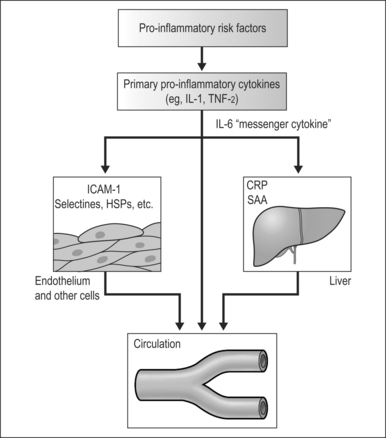Chapter 13 The impact of surgical treatment of OSA on cardiac risk factors
Evidence supporting the association between OSA and cardiovascular diseases is compelling. In a retrospective analysis of 182 men without history of cardiovascular disease at baseline, Peker et al. found that incompletely treated OSA was an independent predictor for cardiovascular disease in this group of patients at 7 years of follow-up.1 Several case–control studies in patients with myocardial infarction also support an increased risk of cardiovascular morbidity in patients with OSA, with odds ratios in the range of 4.1 to 4.5 over control population.2 Partinen et al. followed 198 patients with OSA for 5 to 7 years and showed that patients who were treated conservatively had more than twice the risk of developing new cardiovascular disease and nearly five times the risk of cardiovascular or stroke-related death when compared to those patients treated by tracheotomy.3
A number of possible mechanisms by which OSA might affect cardiovascular function have been hypothesized. Repetitive hypoxemia and hypercapnia throughout the night may be responsible for vascular injury and acceleration of atherosclerosis,4 chronic sympathetic hyperactivity,5 elevation of fibrinogen,6 pulmonary hypertension, right heart hypertrophy7 and failure,8 and increased risk of plaque ruptures and subsequent cardiovascular event.9
In recent years, several serum markers have been investigated as potential surrogate biomarkers for monitoring and predicting cardiovascular events. These serum biomarkers include leptin, matrix metalloperoxidase, proteins involved in the angiotensin–aldosterone axis, nitric oxide, plasma cytokines, tumor necrotizing factor a (TNF-a), interleukin-1 (IL-1), IL-6, IL-8, IL-10, IL-18, and inflammation markers such as fibrinogen, high-sensitivity C-reactive protein (hs-CRP), and serum amyloid A (SAA). The important role that inflammation played in the process of atherosclerosis has become well established over the past decade.10 Inflammatory cells and cytokines are involved in virtually every step in atherogenesis.11
The inflammatory cascade can be activated by noxious stimuli such as the repetitive hypoxemia associated with untreated or poorly treated OSA. Activation of the inflammatory cascade leads to secretion of proinflammatory cytokines, such as TNF-a and IL-1. IL-1 then activates IL-6 which upregulates the production of CRP in the liver. CRP is a pro-oxidant that induces expression of adhesion molecules, such as ICAM-1 and VCAM-1, and production of monocyte chemoattractant protein-112 (Fig. 13.1). These factors facilitate the attachment and migration of monocytes into the subintimal spaces of the blood vessels. The monocytes are then transformed into macrophages and take up cholesterol lipoproteins which lead to fatty deposits in the subintimal space. Further injurious stimuli propagate the attraction and accumulation of macrophages, mass cells, and activated T cells, with resultant formation and growth of atherosclerotic plaque. Secretions of metalloproteinases and other connective tissue enzymes by activated macrophages may cause breakdown of collagen and make these plaques more prone to rupture. Disruption of the atherosclerotic plaque exposes the atheronecrotic core to arterial blood and leads to thrombosis.13
Evidence suggesting an association between OSA and inflammatory factors includes the findings of increased plasma IL-6, CRP, and fibrinogen in patients under hypoxic conditions at high altitude,14 as well as increased daytime plasma levels of IL-6 in patients after sleep deprivation and patients with excessive daytime sleepiness.15 A study by Shamsuzzaman et al. indicated a strong association of OSA and elevated CRP levels.16 In their study, 22 patients with newly diagnosed OSA showed significantly higher CRP levels compared to the control group (0.81 ± 0.15 mg/dl vs. 0.28 ± 0.12 mg/dl). Minoguchi et al. measured carotid intima-media thickness (IMT) and serum CRP, IL-6, and IL-18 levels in patients with OSA (n








